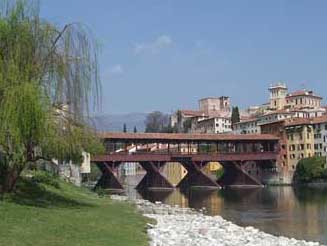About Bassano del Grappa
Bassano del Grappa is a medium-sized town (population 40,000) located in the Veneto region of northern Italy, in the province of Vicenza (Provincia di Vicenza). The town is situated at the point where the flat Veneto plains reach the hills leading up to the Alps; it takes its name from the nearby Monte Grappa. The four things for which Bassano del Grappa is best known are its covered bridge over the Brenta, the strong grappa liqueur produced in the area, the military history of Monte Grappa and locally-produced ceramics. Like so many of the Veneto’s historic towns, this is a prosperous place and is studded with smart clothes and furnishings shops. The architecture reflects Bassano’s location: typical Veneto-style arcaded streets and piazzas are interspersed with alpine wooden balconies, and some of the hostelries have a decidedly Austrian flavour.
The historic centre of Bassano is pretty and very compact: there are several sights to see and the town makes a good day-trip destination. It is connected by direct regional trains to Padua and Venice. It would also make an unusual base for a couple of days exploring this area between the mountains and the Veneto plain.
Find and book hotels. With location maps and guest reviews.
Tourist sights
The most famous view of Bassano del Grappa is of its principal landmark, the Ponte degli Alpini, also known as the Ponte Vecchio (‘Old Bridge’). This covered wooden bridge over the broad Brenta river was designed by Andrea Palladio in 1569 to replace earlier incarnations. The use of wood helps the structure to cope with the onslaught of flooding as melted snow rushes down from the mountains. The bridge has been rebuilt more than once to the same design, and its current name dates back to the rebuilding after destruction in the Second World War, which was carried out by the Alpini, Italy’s Alpine Troops. The insignia of the Alpini can be seen all over Bassano del Grappa and in the souvenir shops too. At the western end of the bridge is a little museum dedicated to them: the Museo degli Alpini (entered through the tavern above). This contains photographs and relics of various military campaigns, but principally the First World War fighting on Monte Grappa. The museum also contains photos and items recording the local horror of 1944 when the occupying Germans hung 31 Italian partisans from trees. The panoramic Viale dei Martiri is now named for these men, and they are recorded by little shrines along its length. Despite the sad memories, this is a lovely stretch of street with benches to admire the views of the mountains: you shouldn’t leave Bassano del Grappa without strolling along this amphitheatre.
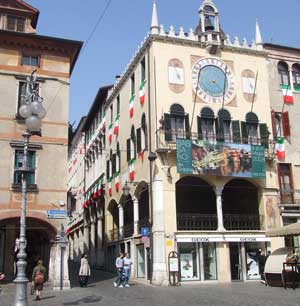
The Museo Civico, the town museum, is situated in the former convent alongside the church of San Francesco in Piazza Garibaldi. It has a small archaeological section with finds from local excavations, and also a fine collection of Apulian vases donated by a local collector. The museum’s main attraction can be found upstairs, though, where a spacious art gallery houses many works by the local dal Ponte or Bassano family, including a hall dedicated to the most renowned: Jacopo Bassano (or dal Ponte, or da Ponte) with many of his works gathered from local churches and buildings. There are also works by other artists, many local, including views of Venice and other parts of Italy, portraits. A small room pays tribute to the opera singer Tito Gobbi who was from Bassano: along with a bust you can admire some of his opera costumes. A larger exhibition space is devoted to the sculptor Antonio Canova, and contains many of his plaster models for statues. There is an admission charge (4 at the time of writing; or 5 for a combined ticket with Bassano’s other civic sights).
Bassano’s famous alcoholic product, grappa, takes its name, like the town, from the mountain. The fiery liqueur, which comes in many varieties, is made from leftovers of the winemaking process. It can be found all over Italy, but this area is particularly renowned for its grappa. One of Bassano’s historic distilleries, Poli, has a little museum – the Museo della Grappa – in its headquarters right by the Ponte degli Alpini, where you can learn how grappa is made and taste it too. Admission is free and the museum is open all day.
One of the finest views of the bridge is from a little terrace at the entrance to another of Bassano’s museums, the Museo della Ceramica at Palazzo Sturm. The museum (included in a combined ticket with the Museo Civico) is housed in an interesting palazzo on the bank of the River Brenta, and contains displays of local ceramics and majolica ware. If you are visiting during its limited opening hours (weekends, holidays and summer; closed lunchtimes) it’s worth climbing the fourteenth-century Torre Civica (civic tower) in Piazza Garibaldi for views over Bassano. Nearby in Piazza della Liberta, another large square, is the former base of the town’s ruler, later the town hall: the Loggia dei Podestà and Palazzo del Comune. The fifteenth-century building has a large clock face in its facade, dating to 1430 (though the internal workings are more recent), and although most of its external frescoes are lost it still features a painting of St. Christopher by Francesco Bassano (or da Ponte) il Vecchio, father of Jacopo.
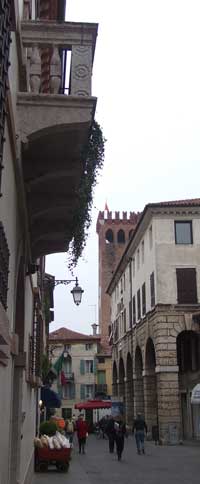
Apart from Bassano’s official tourist attractions, the town centre is composed of attractive streets and three attractive linked piazzas ornamented with cafes, shops, churches and chatting locals. There are several pretty view-points, particularly on the bank of the Brenta downstream from the bridge where local people relax on the grass and stony riverbank in the sunshine among ducks and geese. Bassano is proud of its botanic gardens, the Giardini Parolini, which were created by a local enthusiast in the early nineteenth century and now, on a reduced scale, form a public park. On the top of its hill, Bassano is dominated by its castle complex, the Castello degli Ezzelini. The castle itself can only be toured by prior arrangement for groups, but you can enter the courtyard and visit the town’s Duomo inside the walls. This cathedral, the Duomo di Santa Maria in Colle is unfortunately only open on Sunday mornings. Other interesting churches include the little Chiesa di San Donato, which lies down an alley on the far side of the Ponte degli Alpini. This is a small historic church with vanishing frescoes and a sweet altarpiece by Francesco Bassano il Vecchio.
Eating, planning and practicalities
The tourist information office in Bassano del Grappa is conveniently located between the railway station and the heart of town. If you are arriving by train, take the street opposite the station and walk straight on towards the main road which skirts the old town walls. Crossing over, you will find the tourist information office just inside the walls. It stocks a good range of information including town maps and free guides in English.
There are lots of bars around town where you can buy sandwiches and light meals as well as drinks. Many have pleasant outdoors seating and are tempting places to while away half-an-hour or more. I ate at the stylish Caffè Ponte Vecchio on the western side of the bridge, which offered a good short food menu with local specialities like asparagus as well as selected local wines by the glass. There are also a number of more formal restaurants dotted around the centre which you will pass as you wander. Many shops sell local specialities – from cakes to grappa – as well as ceramics and souvenirs. Apart from the grappa drink, Bassano’s most prized food product is white asparagus. In April this speciality is celebrated with various culinary events.
Unusually, and conveniently, three of Bassano’s museums are open all day with no lunchtime closure. Most of the churches, and the ceramics museum at Palazzo Sturm, close for several hours at lunchtime, so these are the sights you’ll need to accommodate in your schedule. The Torre Civica has limited opening times.
Travel to Bassano del Grappa
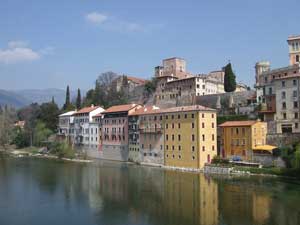
By train: Bassano del Grappa is connected with Venice by direct regional trains. Fares are cheap and the journey takes an hour and twenty minutes. There are also direct rail services to Padua (varying journey times, from 45 minutes upwards) and Trento (two hours). Travelling to Vicenza involves changing trains, so the bus is easier and at one hour, the journey is just as quick.
By bus: Bassano del Grappa has a little bus station (autostazione) in Piazzale Trento, by the town wall, just south of the tourist information office and a five-minute walk from the railway station. It consists of some parking bays for buses, a shelter with timetables pasted on the wall and a news-stand where you can buy tickets (which was closed for an extended lunch when I visited, so stock up on tickets while you can). There is also a row of bus stops on the street opposite the station. Ferrovie Tramvie Vicentine (FTV) run many bus services linking the towns in this area. There are fairly frequent bus services which connect Bassano with nearby Marostica, some continuing to Vicenza. A number of other bus companies serve Bassano – the timetables at the bus station are simple and quite easy to follow. Bus companies include La Marca, who run a Treviso-Montebelluna-Bassano service, CTM, and the long-distance coach company Sita. Bus service websites are listed in our links panel on the right – they are mostly in Italian; timetables can be found under orari. Touring the area by bus is entirely possible, but you will need to be organised, study the timetables closely for variations on weekdays, schooldays, summer and holidays, be prepared to fit your days around bus timetables and stock up on tickets before the sales points (usually news-stands) shut for lunch.
By air: The nearest airports to Bassano del Grappa are Treviso Airport, served by Ryanair (as ‘Venice Treviso’), Venice Marco Polo, and Verona.
Things to do around Bassano del Grappa
Marostica, around five miles away, is famous for a human chess game which takes place in the town each September, with historical costumes and re-enactments. It’s also an attractive little fortified town which is worth visiting at other times of the year. Bus services connect Marostica with Bassano del Grappa. The train service to Venice is also useful for travellers who are exploring the area using public transport. As well as Venice itself, the train also stops in Castelfranco Veneto, close to Bassano, which is another picturesque small town with a famous picture by local artist Giorgione in its Duomo. A touring itinerary in this part of Italy could join together Vicenza, Marostica, Bassano, Cittadella, Castelfranco Veneto, Asolo (once home to Robert Browning), Treviso and Padua, perhaps travelling onwards to Venice to rejoin the tourist trail. This would be a lovely holiday experience away from the crowds, enjoying green countryside, the rolling hills at the foot of the Alps, fine architecture, historic towns, art galleries and excellent local food and wines.
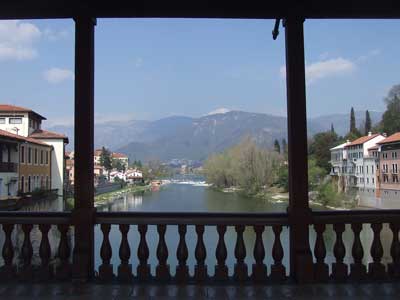
Bassano del Grappa accommodation
It’s not often seen as a holiday base, but staying in Bassano for a couple of nights would be a good way to explore the quiet attractions of this part of the Veneto, especially if you’re relying on public transport.
> Bassano del Grappa hotels and B&Bs
Useful external links
Sita buses (choose ‘Veneto’ region)
Veneto destinations
- Veneto region
- Abano Terme
- Asolo
- Bassano del Grappa
- Brenta Canal
- Caorle
- Castelfranco Veneto
- Chioggia
- Cittadella
- Concordia Sagittaria
- Conegliano
- Cortina d’Ampezzo
- Lido di Jesolo
- Malcesine
- Marostica
- Monselice
- Montegrotto Terme
- Padua
- Portogruaro
- Rovigo
- Sottomarina
- Treviso
- Venetian Lagoon
- Venice
- Verona
- Vicenza
- Veneto art & architecture itinerary
- Veneto villas – Vicenza: La Rotonda & Villa Valmarana ai Nani
- Veneto villas – Villa Pisani & Villa Foscarini Rossi, Strà
- Venice Airport
- Treviso Airport
